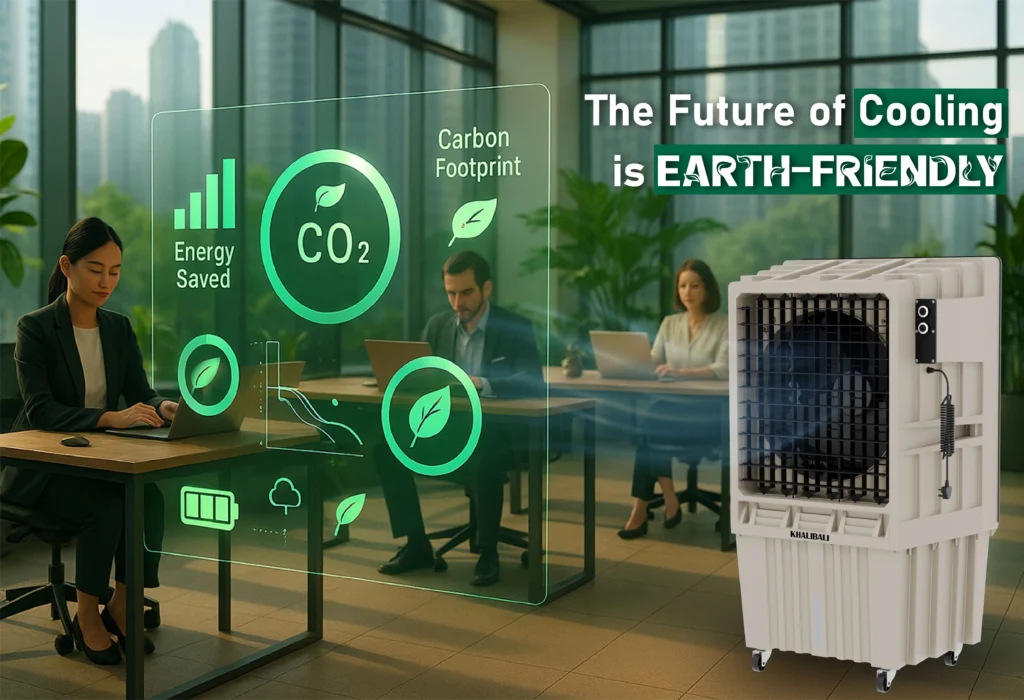As climate change continues to shape global business practices, companies across India are reevaluating their energy management strategies, particularly in office cooling. Most workplaces rely heavily on air conditioning to maintain comfort. Still, few realize how much it contributes to their carbon footprint, the total amount of greenhouse gases produced directly or indirectly by their operations. With India’s long summers and increasing energy demands, finding an eco-friendly way to stay cool has become more important than ever.
An air cooler is one of the most effective and sustainable alternatives gaining popularity nowadays. Compared to traditional air conditioners, air coolers consume far less electricity, emit no harmful gases, and create a natural cooling environment. Let’s understand how making this simple switch can significantly reduce your office’s carbon footprint.
The Problem: Cooling and Energy Use in Offices
Cooling systems are among the biggest consumers of electricity in commercial and corporate buildings. Across India, air conditioners account for a major share of total energy use in offices, shopping centers, and industrial spaces. According to estimates, cooling and HVAC systems can consume 40–50% of a building’s total electricity, leading to enormous power bills and high carbon emissions.
The fact that the majority of India’s electricity still originates from coal-based power plants, which emit enormous volumes of carbon dioxide (CO₂) into the atmosphere, makes this even more alarming. Greenhouse gas emissions increase with each kWh of electricity used. The environmental cost is enormous in places like Bengaluru, Delhi, and Mumbai, where offices use air conditioning for eight to ten hours every day.
As businesses adopt greener practices and commit to sustainability goals, reducing energy consumption from cooling has become a critical step. This is where air coolers offer a practical, sustainable, and cost-effective solution.
How Air Coolers Work (Evaporative Cooling Made Simple)
An air cooler works on a simple and natural principle evaporative cooling. It draws in warm air from the surroundings and passes it through water-soaked cooling pads. As the air moves through these pads, the water evaporates, absorbing heat and releasing a stream of cool, fresh air.
Unlike air conditioners, air coolers don’t rely on compressors, refrigerants, or heavy electrical components. They simply use a fan, water pump, and a small motor to circulate air making them energy-efficient and eco-friendly.
The absence of harmful refrigerant gases like CFCs or HCFCs means they do not contribute to ozone depletion or global warming. Moreover, air coolers constantly circulate fresh air instead of recirculating indoor air like air conditioners, which helps maintain better air quality inside offices. In essence, air coolers deliver natural cooling with minimal energy use and zero environmental harm.
Environmental Benefits of Using Air Coolers in Offices
Switching from air conditioners to eco-friendly air cooling systems offers several environmental advantages that directly help reduce your office’s carbon footprint. mainly, lower energy consumption means fewer power plant emissions. Since air coolers consume up to 80% less electricity than traditional ACs, the indirect CO₂ released through electricity generation is drastically reduced.
Air coolers don’t use refrigerants, which are among the leading contributors to greenhouse gas emissions. Traditional air conditioners release hydrofluorocarbons (HFCs) that trap heat in the atmosphere, intensifying global warming. By choosing air coolers, offices eliminate this risk.
Unlike air conditioners, which reuse the same indoor air, air coolers continuously draw in fresh outdoor air, making office spaces healthier. This constant supply of pure air keeps the air clean, lowers indoor pollution, and makes the workplace more comfortable for workers.
Cost and Sustainability Comparison: Air Cooler vs. Air Conditioner
To understand how air coolers truly make a difference, let’s compare them with air conditioners in key sustainability areas:
| Aspect | Air Cooler | Air Conditioner |
|---|---|---|
| Electricity Use | 150–300 watts per hour | 1,500–2,000 watts per hour |
| Refrigerants Used | None | CFCs, HCFCs, or HFCs |
| CO₂ Emissions | Very low | High (due to electricity use and gases) |
| Air Quality | Fresh natural airflow | Recirculated indoor air |
| Operational Cost | Low | High |
| Environmental Impact | Eco-friendly | High carbon footprint |
How Offices Can Implement Eco-Friendly Cooling
Transitioning to sustainable cooling doesn’t have to be complicated. Offices can start by installing large-capacity air coolers in open-plan areas, conference halls, or cafeterias where air conditioners consume the most power. For hybrid spaces, a combination of air coolers and ventilation systems can maintain comfort while reducing overall energy demand.
Businesses can also explore solar-powered air coolers, which use renewable energy to further reduce dependency on fossil fuels. Proper maintenance such as cleaning cooling pads, using soft water, and ensuring good cross-ventilation enhances performance and extends lifespan.
Modern coolers now come with smart controls, automatic water refilling, and humidity management, making them ideal for commercial use. Implementing these systems can significantly lower operational costs while supporting corporate sustainability targets.
Conclusion
Cooling is essential for every workplace, but the way we cool our spaces defines our environmental impact. By replacing or supplementing traditional air conditioners with air coolers, businesses can significantly cut down on energy use, reduce greenhouse gas emissions, and move closer to achieving a green office environment. Air coolers represent the perfect balance between comfort, efficiency, and sustainability, offering a smarter and more responsible way to stay cool.
At Raj Cooling Systems Pvt. Ltd., we take pride in offering a wide range of energy-efficient, eco-friendly air coolers designed for offices, factories, and commercial spaces across India. Each product is engineered to deliver maximum cooling with minimal environmental impact. so this summer, make the switch. Choose energy-efficient air coolers for your workplace and contribute to a greener tomorrow because every cool breeze can make a difference.

